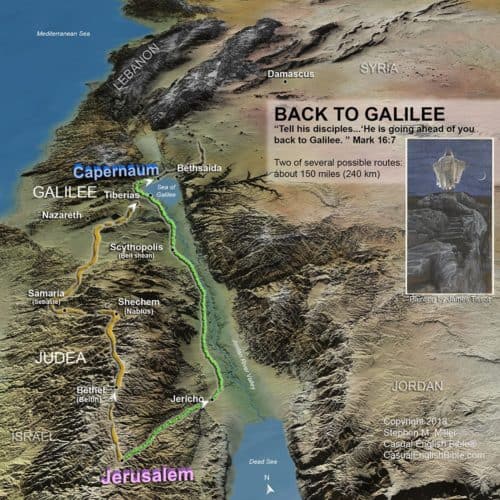Mark 16
He’s back
Jesus, Alive Again
1When the Sabbath ended at sundown on Saturday, three women went out and bought burial spices [1] they could use to anoint the body of Jesus. The women were Mary Magdalene, Mary the mother of James, and Salome. 2Early the next morning, on Sunday, the women went to the tomb. The sun had risen. [2] 3As they walked along they talked among themselves, asking, “Who can we get to roll that big stone away from the entrance to the tomb, so we can get inside?” 4But when they got there, they saw that someone had already rolled the stone away. This was a huge stone.5They went inside the tomb. There they saw a young man wearing a white robe and sitting just to the right of the entrance. That rattled them instantly. 6But he told them, “Take it easy. Don’t get upset. You’re looking for Jesus the Nazarene, the one who was crucified. He has been raised. He’s not here anymore. Take a look over there. That’s where they put his body. 7Go back and tell his disciples, including Peter, ‘He is going ahead of you back to Galilee. You can meet him there, just as he told you earlier.’”
8The women left the tomb and took off running. They were so shocked that they had the shakes. At that point they didn’t say a thing. [3] They were terrified speechless. [4]
{Most ancient copies of the Gospel of Mark, oddly, end here.}
Disciples Don’t Believe Mary Magdalene
9When Jesus rose from the dead early Sunday morning, the first day of the week, Mary Magdalene was the first to see him. Jesus had performed an exorcism on her, driving out seven demons. [5] 10Mary went back and told his disciples, who were crying over his death. 11But when she said she had seen him alive, they absolutely refused to believe her.12Later, Jesus appeared to two of his followers as they were walking into the countryside. [6] But he looked different. [7] 13When the two got back, they told the others what happened. No one believed them. 14Later, Jesus showed up while the 11 disciples were sitting down, reclining beside a table. He scolded them a bit for their stubborn refusal to believe the others, who said they saw him alive again.
Job Description for the Disciples
15Jesus told the disciples, “Spread the good news. Tell it to everyone everywhere. 16Whoever believes and gets baptized will be saved. Those who don’t won’t. They’ll be condemned.17“Here’s how you’ll recognize the people who actually believe what you have say. They’ll invoke the authority of my name to perform exorcisms. They’ll speak in spiritual languages. [8] 18They’ll pick up snakes with their bare hands. If they drink deadly poison, it won’t hurt them—not at all. [9] They’ll heal sick people by touching them; the people will get well.”
19After their leader, Jesus, finished talking to them, he was taken up into heaven. There, he sat down at the right hand of God. 20The disciples hit the road, telling the story of Jesus everywhere they went. The Lord worked alongside them, backing up their message with miracles.
Footnotes
Perfumes and fragrant spices placed on the body and in the linen wrapped around the body helped mask the smell of decay while family and friends mourned at the tomb.
So had the Son.
Funny thing about the writer credited with writing this book that seems to have misplaced its ending. He was perhaps most famous for not finishing what he started. He joined his cousin Barnabas along with Paul on Paul’s first-known mission trip. But when they reached the swampy southern coast of Turkey, “John Mark decided to turn around and go back to Jerusalem” (Acts 13:13). Paul was so livid that he rejected Mark’s request to let him come on the second mission trip. But the two reconciled later and traveled together.
The Gospel of Mark ends here in the oldest copied manuscripts. Those are the ones that Bible experts generally say are the most reliable. They suggest that someone later added the following verses by pulling from the other Gospels—possibly to give Mark an ending that doesn’t leave people saying, “Huh?”
This closing section (Mark 16:9-20) reads like a compilation borrowed from the other Gospel stories. Many Bible experts say that somewhere along the line, some editor probably felt that the Gospel of Mark needed a little extra material added to the end of the book. So the editor pulled a few strands from the other Gospels to wrap up the loose ends in Mark. Most writers know that editors are certainly willing and able to do this, if given the chance. When scholars review all of the ancient copies of Mark, there are actually four different endings. (1) The most reliable ends at 16:8. (2) There’s another, nicknamed the “Short Ending,” which includes this little wrap-up paragraph after verse 8: “The women briefly told Peter and the other disciples what happened. Later, Jesus sent the disciples on the road east to west with the message of salvation that is holy, indestructible, and loaded with the gift of eternal life. And that’s the truth.” (3) A third ending, nicknamed the “Long Ending,” includes all 20 verses. (4) The fourth ending includes all of the 20 verses given in the text, plus the “Short Ending.” We might as well go ahead and call that the “Long and Short of It Ending.”
“Two followers of Jesus were walking to the village of Emmaus, about seven miles [11 km] from Jerusalem. . . . Jesus caught up and started walking with them” (Luke 24:13, 15).
More literally, “he appeared in another form.” “They weren’t able to recognize him” (Luke 24:16).
The writer uses the Greek word glossa, often translated as “tongues.” It can mean other human languages. But it can also mean a spiritual language that can sound to others like gibberish. Many early Christians, including Paul and Christians in Corinth, seemed to believe that the Holy Spirit allowed some people to speak in a language that Paul once described as the “tongues of angels” (see 1 Corinthians 13:1). Some Bible experts say that Paul put this gift last on this list because it was causing problems at the church in Corinth. It disrupted worship services when someone would stand up and start talking in a language that made no sense to most people in the room. Paul addresses the problem in 1 Corinthians 14.
Whoever wrote this may have had in mind Paul’s snakebite (Acts 28:3-5) or snakes that bit the Jews when Moses led the Jews on their exodus out of Egypt (Numbers 21:4-9). Or maybe it referred to Jesus telling his 72 followers, “You can walk on snakes and scorpions. Nothing can hurt you” (Luke 10:19).
Discussion Questions
- 1
Why can’t the Gospel writers get their story straight? Mark says three women went to the tomb of Jesus and saw a young man in a white robe (Mark 16:1, 5). Matthew says there were two women who saw one angel with a glowing face (Matthew 28:1, 3). Luke says there were several women who saw two men wearing clothes that had a dazzling shine (Luke 23:55; 24:1, 4). John says Mary Magdalene was alone, and that she saw two white-robed angels (John 20:11-12).
- 2
What’s up with the three women keeping their mouths shut after the young man at the tomb told them to tell Peter and the other disciples that Jesus was alive again? It’s not only a terrible way to end a book, many would say, it seems the opposite of what any normal human being would do.
- 3
The young man sitting in the tomb, presumably an angel, told the women, “Go back and tell his disciples, including Peter” (Mark 16:7). They were to deliver the news that Jesus was alive again. Why do you think the angel might have added a special reference to Peter? It’s okay to guess. That’s what everyone has to do when it comes to this question.
- 4
After the women saw the empty tomb and heard the young man tell them that Jesus had been raised from the dead, the women found it impossible to convince the disciples about any of this. “They absolutely refused to believe her” (Mark 16:10). Since Jesus had told his followers this was going to happen, what do you think made it so difficult for them to believe it?
- 5
Mark says that the resurrected Jesus appeared to two of his followers who were out walking in the countryside, “But he looked different” (Mark 16:12). Luke seems to fill in some of the details when he says that Jesus appeared to two of his followers who were walking outside of Jerusalem toward the village of Emmaus. “They weren’t able to recognize him” (Luke 24:16). What do you make of this?
- 6
There are Christians today who handle poisonous snakes during worship services. They drink toxic liquid as well. Fortunately, most seem to survive. Some die. Why on earth do you think someone apparently added to the Gospel of Mark a verse that says a real Christian is someone who can pick up snakes with bare hands and drink deadly poison—and then survive (Mark 16:18)?
- 7
The Gospel of Mark ends one of four different ways, depending on which ancient copy of the book we read. Which ending makes most sense to you?
- 1. Version ending at 16:8.
- 2. Version nicknamed “Short Ending,” which includes this paragraph after verse 8: “The women briefly told Peter and the other disciples what happened. Later, Jesus sent the disciples on the road east to west with the message of salvation that is holy, indestructible, and loaded with the gift of eternal life. And that’s the truth.”
- 3. Version nicknamed “Long Ending,” which includes all 20 verses.
- 4. “Long Ending,” which includes all 20 verses given in the text here, plus the “Short Ending.” We might as well go ahead and call that the “Long and Short of It Ending.”
- 8
If Mark really did end his book about the life and teachings of Jesus at verse 8, with the women not saying anything about the Resurrection to anyone, why do you think he did something like that? Did he run out of parchment?







